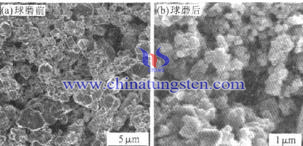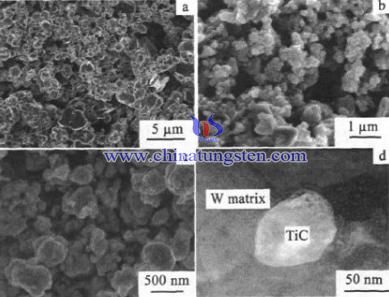CVD Diamond Coated Carbide Cutting Tool Pretreatment—Acid Etching
- Details
- Category: Tungsten Information
- Published on Friday, 15 January 2016 17:48
- Written by xiaobin
- Hits: 271
As a result of several technical matters of CVD coated cemented carbide, the researchers and scholars has developed some pretreatment for tungsten carbide cutting tool, which can remarkably improve the binding force or adhesion between CVD diamond coating and tungsten carbide matrix. It mainly includes acid etching removes cobalt (Co), plasma etching removes cobalt (Co), applying various transition layer and mechanical or chemical heat treatment and so on. This paper is focused on introducing acid etching.
Theoretically, acid etching usually uses some inorganic acid (such as hydrochloric acid (HCl), nitrate ACID (HNO3), sulphuric acid (H2SO4), hydrofluoric acid (HF), and phosphoric acid (H3PO4)) to remove the metallic oxide of the surface, which is the most widely used in the surface of tungsten carbide Co removing. The cemented carbide containing corrosive acid into the etching is performed so that the surface layer of the cobalt and the acid react to form a stable compound, thereby removing the surface layer contained cobalt (Co). Since after the removal of molybdenum, tungsten carbide WC substrate surface defects left, which will also reduce the surface of the barrier, so that the carbon atoms in the defect aggregate to form carbon radicals, radicals increases as the particle size, wherein the diamond growing phase, so the final formation of the diamond core, diamond between the film and the cemented carbide is improved.
Acid etching includes one-step process and two-step process. Although one-step etching method, the deposited diamond film and the substrate have good adhesion, but because tungsten can not easily etched by acid, thus impeding the acid erosion of deep cobalt. The two-step etching method of the deposited diamond crystal is better, and the combined strength of the matrix is higher, but it remains some defects, one is loose structure controlling (Nucleation loose structure is due to cobalt-depleted cobalt zone at high temperature and pressure to the cemented carbide substrate surface diffusion occurs, the surface of the cobalt-depleted zone will be gradually reduced until it disappears, strong graphite suppression of Co bonded diamond grains meet and growth, and the surface of the substrate nucleation and growth of a large number of non-diamond phase, which ultimately affect the quality of diamond film deposition.); The other one is two-step method is not suitable for the tools machining with small size (it has an bad influence on breaking strength).
| Tungsten Carbide Supplier: Chinatungsten Online tungsten-carbide.com.cn | Tel.: 86 592 5129696; Fax: 86 592 5129797;Email:sales@chinatungsten.com |
| Tungsten News&Tungsten Prices, 3G Version: http://3g.chinatungsten.com | Molybdenum News & Molybdenum Price: http://news.molybdenum.com.cn |
Dressing of Scheelite and Wolframite Mixture Ore
- Details
- Category: Tungsten Information
- Published on Friday, 15 January 2016 17:30
- Written by xinyi
- Hits: 307

| Tungsten Supplier: Chinatungsten Online www.chinatungsten.com | Tel.: 86 592 5129696; Fax: 86 592 5129797;Email:sales@chinatungsten.com |
| Tungsten News & Prices, 3G Version: http://3g.chinatungsten.com | Molybdenum News & Molybdenum Price: http://news.molybdenum.com.cn |
Preparation of Titanium Carbide Covered with Tungsten Nanosize Composite Powder from Ammonium Paratungstate 1/2
- Details
- Category: Tungsten Information
- Published on Friday, 15 January 2016 16:43
- Written by chunyan
- Hits: 259
Method of mechanical-alloying is commonly used in preparation of W-TiC alloy at present, which is using high energy grinder and ball grinder to achieve solid state alloying. However, because of the abrasion of grinding ball and ball milling tank, it is easy to introduce a large number of impurities, thereby causing the minor change of components. At the same time, the process of ball grounding will introduce large numbers of mechanical energy which make the powder stands in high energy activation state, accelerate the growth of grain in the sintering process; and due to the high internal stress, crackles will come into being in the process of briquette sintering which seriously affect the properties of W-TiC alloy. So it is urgent to find a new method for preparing composite powder of tungsten without crackles at the grain boundary, and material will not failure because of the stress concentration.
A new method for preparing W-TiC powder was proposed in this paper, which is preparing titanium carbide covered with tungsten nanosize composite powder by using ammonium paratungstate (APT) as raw material. Changing the state of TiC on the tungsten surface, not only can make the TiC uniform distribution and avoid agglomeration, overcome the problem in Mechanical-alloying method, but also can reduce impurities and controlling the composition of TiC at the same time.

Reaction principle: oxalic acid and APT reacting at a certain temperature and other conditions, crystallization for getting precursor powder of W-TiC. After adding APT into oxalic acid, the react between them will not occurred immediately which makes tungsten has enough time to nucleation on the surface of TiC powder, so structure that TiC covered with tungsten came into being. And then, tungsten nucleation in the home position to obtain titanium carbide covered with tungsten nanosize composite powder in the process.
Equipments: ultrasonic dispersing device, stirring device and drying device, tube oven for sintering
Reactants and reagents: oxalic acid, titanium carbide powder (TiC), ammonium paratungstate powder (APT)
| APT Supplier: Chinatungsten Online ammonium-paratungstate.com | Tel.: 86 592 5129696; Fax: 86 592 5129797;Email:sales@chinatungsten.com |
| Tungsten News&Tungsten Prices, 3G Version: http://3g.chinatungsten.com | Molybdenum News & Molybdenum Price: http://news.molybdenum.com.cn |
Preparation of Titanium Carbide Covered with Tungsten Nanosize Composite Powder from Ammonium Paratungstate 2/2
- Details
- Category: Tungsten Information
- Published on Friday, 15 January 2016 16:49
- Written by chunyan
- Hits: 260
The specific process is as follows:
1. Preparing W-TiC precursor
(1) Adding TiC powder into oxalic acid solution and dispersion by ultrasonic for 20-30min to make it well distribution. The concentration of oxalic acid is supposed to be 84-134g/L, and the quantity of TiC powder added to be 0.833g/L; in addition, the frequency of ultrasonic is 40KHz and the power is 100-400W;
(2) Adding ammonium paratungstate (APT)into the solution above, the amount of APT added is 56-114.3g/L→heated to 155-185°C, stirring in the constant temperature, reacting for 90-240min→drying→get the W/TiC precursor;

2. Reduction, also the sintering process
Placing the W-TiC precursor prepared by step 1 into the tube oven and sintering in the flowing hydrogen gas, and then powder of titanium carbide covered with tungsten nanosize composite is obtained. The content of hydrogen is at most 99.999%.
The specific sintering process is as follows: [heating rate is 5°C /min, cooling down rate is 5 °C /min].
(1) Heating up to 200°C, keep for 30min;
(2) Then heating up to 500°C, keepfor 60min;
(3) And then heating up to 800°C, keep for 60min;
(4) Go on cooling naturally with the oven after cooling down to 500°C.
The nanosize W-TiC powder prepared by the method has the following prosperities: the composition of tungsten and TiC can be controlled; avoid to introducing impurities, and the purity and degree of uniformity of W-TiC to be very high; the particle size of W-TiC to be 100nm.
| APT Supplier: Chinatungsten Online ammonium-paratungstate.com | Tel.: 86 592 5129696; Fax: 86 592 5129797;Email:sales@chinatungsten.com |
| Tungsten News&Tungsten Prices, 3G Version: http://3g.chinatungsten.com | Molybdenum News & Molybdenum Price: http://news.molybdenum.com.cn |
Preparation of Nanometer Yttrium Oxide Dispersion Tungsten Strengthened Alloy from Ammonium Paratungstate 2/2
- Details
- Category: Tungsten Information
- Published on Friday, 15 January 2016 16:39
- Written by chunyan
- Hits: 238
Principle: yttrium nitrate and ammonium paratungstate mixed in alcohol, yttrium enter tungsten in ions, and wrapped by tungsten in the process of calcination and reduction, so to achieve the goal of spread in tungsten powder before sintering. After pressing and sintering, yttrium oxide will remain nanosize and uniformly dispersed in the tungsten crystals.
Reagent: alcohol, yttrium nitrate(Y(NO3)3▪6H20) ammonium paratungstate, protective gas (vacuum / hydrogen / argon / nitrogen)
Equipment: ball grounding equipment, drying oven, muffle furnace
Concrete implementation steps:
1. Dissolving yttrium nitrate in alcohol, and mixing with ammonium paratungstate (APT) by ball grounding, the mass ratio of two is 1:1000~1:10, ball grounding speed at 120-180r/min, and time for 0.5-12 hours, and then get wet powder;
2. Put the wet powder into a vacuum drying oven at 40-75°C, drying for 12-36 hours;
3. Placing the dried raw material powder into the muffle furnace for calcination at the temperature of 500-9000°C for 1 to 3 hours, and then powder of nanometer yttrium oxide dispersion tungsten strengthened alloy obtained;
4. The reduction process, put powder of nanometer yttrium oxide dispersion tungsten strengthened alloy in the hydrogen, heated to 600-1000°C for 0.5~2.5 hours;
5. Adding activated sintering agent to the nanometer yttrium oxide dispersion tungsten strengthened alloy powder and sintering and forming into a certain shapes. Sintering at the temperature of 1400-1800°C for 0.5~2.5 hours, and then nanometer yttrium oxide dispersion tungsten strengthened alloy obtained. Remarks: The sintering environment can be compression with heating and isostatic pressing with the protective gas hydrogen, vacuum, argon or nitrogen.
| APT Supplier: Chinatungsten Online ammonium-paratungstate.com | Tel.: 86 592 5129696; Fax: 86 592 5129797;Email:sales@chinatungsten.com |
| Tungsten News&Tungsten Prices, 3G Version: http://3g.chinatungsten.com | Molybdenum News & Molybdenum Price: http://news.molybdenum.com.cn |





 sales@chinatungsten.com
sales@chinatungsten.com